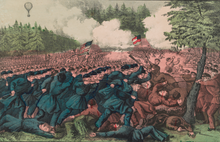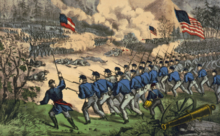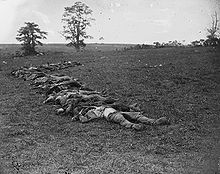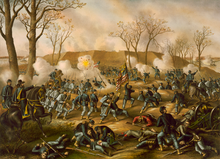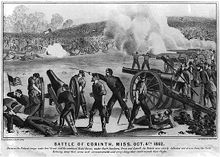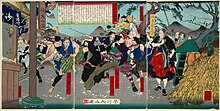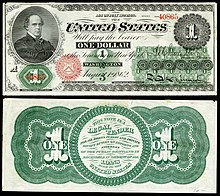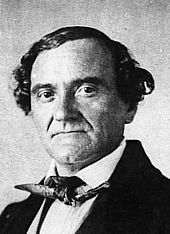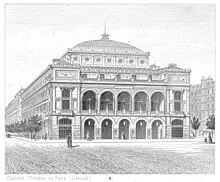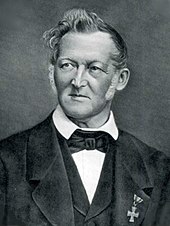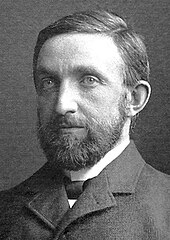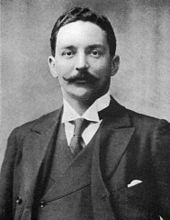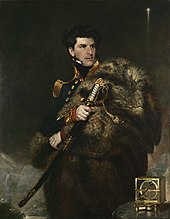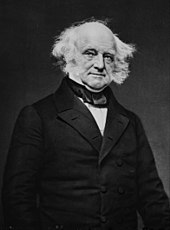1862
Portal History | Portal Biographies | Current Events | Annual Calendar | Article of the day
◄ |
18th Century |
19th Century
| 20th Century
| ►
◄ |
1830s |
1840s |
1850s |
1860s
| 1870s
| 1880s
| 1890s
| ►
◄◄ |
◄ |
1858 |
1859 |
1860 |
1861|
1862
| 1863
| 1864
| 1865
| 1866
| ►
| ►►
| 1862 | |
|---|---|
 King Wilhelm I appoints Otto von Bismarck Prime Minister of Prussia to implement army reforms King Wilhelm I appoints Otto von Bismarck Prime Minister of Prussia to implement army reforms
|
 Abraham Lincoln proclaimed the end of slavery in the American Southern States, which were at war , with the Emancipation Proclamation . Abraham Lincoln proclaimed the end of slavery in the American Southern States, which were at war , with the Emancipation Proclamation .
|
 The Battle of Antietam The Battle of Antietam becomes "the bloodiest day in American history". |
|
| 1862 in other calendars | |
| Armenian calendar | 1310/11 (July New Year) |
| Ethiopian calendar | 1854/55 (10/11 September) |
| Baha'i calendar | 18/19 (20/21 March) |
| Bengali solar calendar | 1267/68 (beginning of the year April 14 or 15) |
| Buddhist calendar | 2405/06 (Southern Buddhism); 2404/05 (alternative calculation according to Buddha's parinirvana ) |
| Chinese calendar | 75th (76th) cycle
Year of the Water Dog壬戌 ( at the beginning of the year Metal Rooster 辛酉) |
| Chula Sakarat (Siam, Myanmar) / Dai calendar (Vietnam) | 1224/25 (April New Year) |
| Dangun era (Korea) | 4195/96 (October 2nd/3rd) |
| Iranian calendar | 1240/41 (around March 21) |
| Islamic calendar | 1278/79 (28/29 June) |
| Jewish calendar | 5622/23 (24/25 September) |
| Coptic calendar | 1578/79 (September 10/11) |
| Malayalam calendar | 1037/38 |
| Rumi Calendar (Ottoman Empire) | 1277/78 (March 1) |
| Seleucid era | Babylon: 2172/73 (April turn of the year)
Syria: 2173/74 (October turn of the year) |
| Vikram Sambat (Nepalese calendar) | 1918/19 (April) |
By 1862 at the latest , it was finally becoming clear to the conflicting parties that the American War of Secession was expanding into a long war involving losses for both sides. A march by Union troops on Richmond , Virginia, can only be stopped a few kilometers from the Confederate capital, and the Union capital , Washington , also briefly encounters enemy units in the immediate vicinity during the year.
The Civil War is one of the first to be documented photographically, and the unembellished images of dead soldiers, along with the lack of military successes, are one reason why Abraham Lincoln increasingly lost support for “his” war in the Union, and several as the year progressed commander-in-chief of his army. Even previously formally neutral European states are flirting more and more openly with diplomatic recognition of the confederation . The Battle of the Antietam eventually becomes the bloodiest day in American history . It ends in a tie but can be sold as a tactical victory by the Union as the new Confederate Commander-in-Chief Robert E. Lee is forced to withdraw from Union territory. This gives Lincoln the opportunity for the already prepared Emancipation Proclamation , with which he will declare slavery abolished in those Southern states that are at war with the Union.
In its western territories, the Union is simultaneously fighting a mismanaged Sioux rebellion , which is struggling and bloody to put down after several months.
In neighboring Mexico , the French Emperor Napoleon III. the fact that the US is otherwise occupied, for his military intervention and conquers large parts of the country in the course of the year, even if the defeat at the Battle of Puebla means a brief setback and France's allied powers Spain and Great Britain also withdraw their support .
In Prussia , Otto von Bismarck is appointed Prime Minister . When the liberal-dominated House of Representatives refused to support army reform despite his blood and iron speech, he dissolved it without further ado and proclaimed a “budgetless regiment”, which finally escalated the Prussian constitutional conflict.
events
| chronology | |
|---|---|
| January 1st |
Switzerland : Jakob Stämpfli becomes Federal President for the third time . |
| 11th January |
Honduras : President José Santos Guardiola is assassinated. |
| 12-15 February | |
| February 18th |
The 1st Congress of the Confederate States of America begins its activities. |
| 7th/8th March |
Civil War: Battle of Pea Ridge |
| 8th/9th March |
Civil War: Battle of Hampton Roads |
| March 12th |
The smallpox epidemic begins on the Pacific coast of North America in 1862 . |
| March 23rd | |
| 26./28. March |
Civil War: Battle of Glorieta Pass |
| March 29th |
Civil War: Battle at Stanwix Station |
| 6th/7th April |
Civil War: Battle of Shiloh |
| 12. April |
Civil War: Andrews Raid |
| April 28th |
Civil War: David Glasgow Farragut captures New Orleans . |
| 5th of May |
Civil War: Battle of Williamsburg |
| 5th of May | |
| May 6th |
Elections to the Prussian House of Representatives |
| May 15th |
Civil War: First engagement at Drewry's Bluff |
| May 20th |
Abraham Lincoln signs the Homestead Act . |
| May 29th | |
| 29/30 May |
Civil War: First Battle of Corinth |
| May 31/May 1 June |
Civil War: Battle of Seven Pines |
| 20th June |
Romania : Prime Minister Barbu Catargiu is assassinated. |
| June 25–June 1 July |
Civil War: Seven Days Battle |
| August 9th |
Civil War: Battle of Cedar Mountain |
| August 10th |
Civil War: Nueces River Massacre, 1862 |
| August 17th |
The Sioux Rebellion in Minnesota begins. |
| August 24th |
The Italian lira becomes the sole currency in Italy . |
| 28-30 August |
Civil War: Second Battle of Bull Run |
| September 10 |
Francisco Solano López becomes President of Paraguay . |
| 12-15 September |
Civil War: Battle of Harpers Ferry |
| September 14th | |
| September 14th |
Civil War: Battle of the South Mountain |
| 17th of September |
Civil War: Battle of the Antietam |
| September 22nd |
Abraham Lincoln proclaims the Emancipation Proclamation . |
| September 23rd |
Prussian constitutional conflict : Otto von Bismarck becomes Prime Minister of Prussia. |
| September 26th |
Liechtenstein receives its first constitution. |
| 30. September |
Otto von Bismarck delivers his Blood and Iron speech. |
| 3rd/4th October |
Civil War: Second Battle of Corinth |
| 5th October |
Bartolomé Miter becomes President of Argentina . |
| 5th October |
Civil War: Battle of Hatchies Bridge |
| 8th October |
Civil War: Battle of Perryville |
| October 13th |
Otto von Bismarck dissolves the Prussian House of Representatives. |
| October 24th | |
| November 2 |
The first Vicksburg campaign begins. |
| 11-15 December |
Civil War: Battle of Fredericksburg |
| December 26th |
38 Dakota are publicly hanged in Mankato after the Sioux Rebellion . |
| Ongoing Events | |
| French intervention in Mexico (since 1861) | |
| Civil War in North America (since 1861) | |
| Prussian constitutional conflict (since 1860) and end of the New Era | |
| Federal War in Venezuela (since 1859) | |
| Rotativismo in Portugal (since 1856) | |
| Nian Rebellion (since 1853) and Taiping Rebellion (since 1850) against the Qing Dynasty in China (since 1644) | |
| Bakumatsu (since 1853) of the Edo period in Japan (since 1603) | |
| Second Empire in France (since 1852) | |
| Gründerzeit in Germany and Austria (since about 1840) | |
| Tanzimat reforms in the Ottoman Empire (since 1839) | |
| Victorian era in Britain (since 1837) | |
politics and world affairs
United States/Confederate States of America
Political and strategic developments in the Civil War
- January 14: Republican Simon Cameron is removed as Union Secretary of War and replaced by Democrat Edwin M. Stanton .
- January 27: President Abraham Lincoln , in his Order No. 1 in the American Civil War that all Union armies in all theaters of war are to go on the offensive on February 22nd.
- February 18: The 1st Congress of the Confederate States of America begins operations in Richmond , Virginia. It replaces the one-chamber Provisional Confederate Congress . The members of the two houses of Congress were determined in the elections in November of the previous year.
- March 11: George B. McClellan is removed from office as Commanding General of the United States Army by President Lincoln for lack of accomplishments. His successor will be Major General Henry Wager Halleck on July 23 .
- September 22: With the Emancipation Proclamation , Abraham Lincoln announces the end of slavery in the southern states of the USA, which are at war with the Union, effective January 1, 1863. The final abolition of slavery in the United States does not take place until December 1865 by the 13th Amendment to the United States Constitution .
- November: Democrats win congressional elections.
Eastern theater of war
Union attacks on Confederate seaports
- March 11: St. Augustine , Florida , is taken by the Union.
- March 14: The port city of New Bern , North Carolina , is captured and occupied by a Union army.
- April 11: After about 30 hours of shelling, Confederate Fort Pulaski in Georgia surrenders to Union invaders. This means that Savannah can no longer be reached by blockade runners.
- May: Pensacola , Florida is captured.
Jackson's Shenandoah campaign
- March to June: Jackson's 1862 Shenandoah campaign in western Virginia is a success largely due to the tactics and local knowledge of General Stonewall Jackson and the maps of Jedediah Hotchkiss :
- March 23 Battle of Kernstown is the only General Jackson lost during the campaign. However, he can retain a significant number of Union units, thereby relieving other Confederate armies.
- May 8: At the Battle of McDowell, Jackson fends off several attacks by the Confederate Army under Robert H. Milroy .
- May 23: At the Battle of Front Royal, 900 Northerners surrender after a short, fierce battle. This forces Union troops under General Nathaniel Prentiss Banks to retreat to Winchester .
- May 25 Confederates win First Battle of Winchester. General Banks then moves his troops across the Potomac to Maryland. However, pursuing the defeated troops remains inefficient. On the one hand, the Confederate troops are exhausted, on the other hand, there are once again disputes over competence between Ewell and Jackson. Jackson only begins pursuing the Union troops on May 27 and reaches the Harpers Ferry area on May 29 . After the defeat, Union President Lincoln decides that defeating Jackson's troops is the top priority and, against the advice of his generals, sends two more divisions into the Shenandoah Valley, playing into the hands of General Robert E. Lee 's plans.
- June 8: The Battle of Cross Keys and
- June 9: Battle of Port Republic decides Shendandoah campaign in favor of Confederacy. The Union Army leaves the Shenandoah Valley , strategically important for Virginia .
Peninsula campaign
- March to July: After initial successes in the so-called Peninsula Campaign , the Union Army under the leadership of George B. McClellan is repulsed outside the Confederate capital of Richmond .
- March 8: The Army of Northeastern Virginia is renamed the Army of the Potomac by order of President Lincoln .
- March 8: On the first day of the Battle of Hampton Roads , the Confederate ironclad Virginia , commanded by Franklin Buchanan , sinks and destroys several US Navy wooden warships.
- March 9: On the second day of the Battle of Hampton Roads, the first battle between two armored warships occurs between the CSS Virginia and the USS Monitor , this ends in a draw, but the Virginia is eventually forced to retreat.
- April 5 Army of the Potomac under George B. McClellan begins march on Richmond. The Battle of Yorktown ends May 4th indecisively.
- May 5: The Confederate Army is victorious over a rearguard of Confederate troops at the Battle of Williamsburg .
- May 7 Battle at Elthams Landing ends indecisive.
- May 11: CSS Virginia is scuttled after the fall of Yorktown due to the Union Army advance in the Peninsula Campaign .
- May 15: Union ironclads in First Battle at Drewry's Bluff in the James River are forced to turn by heavy Confederate fire and are unable to continue their advance toward Richmond. The partially seaworthy USS Monitor eventually foundered in a storm off Cape Hatteras , North Carolina, on December 31 , killing 16 crew members.
- May 27: Union victorious in battle at Hanover Courthouse .
- June 1: Confederate forces attacking positions held by the Confederate Army of the Potomac at the Battle of Seven Pines the day before ends in a draw. The Army of Northern Virginia breaks off its fight. General Robert Edward Lee then assumes command of the Confederate troops.
- June 25: The Battle of Oak Grove begins a series of armed conflicts between the Union and the Confederates known as the Seven Days Battle .
- June 26: The Battle of Mechanicsville ends in a heavy Confederate defeat.
- June 27: Battle of Gaines Mill , the third battle of the Seven Days Battle, ends in Confederate victory under Robert E. Lee.
- June 30: The indecisive Battle of Glendale causes heavy casualties on both sides. Around 7,500 people are killed or injured.
- July 1: Despite the Union victory at the final battle, the Battle of Malvern Hill , the fighting of the Seven Days Battle of the Civil War ends in victory for the Confederate army. The capital Richmond , Virginia, could not be taken - mainly due to the hesitant attitude of the commander McClellan - but this is bought with a blood toll of over 20,600 compared to around 15,800 soldiers on the other side for the Confederates .
Northern Virginia Campaign and Maryland Campaign
- August 9: In the Battle of Cedar Mountain , the Confederates under General "Stonewall" Jackson defeat the Union troops and are able to shift the hostilities to northern Virginia.
- August 28–30: Confederates gain victory at Second Battle of Bull Run near Manassas Junction . As a result, the Confederate Army of Northern Virginia invades Maryland .
- September 1: Just 12 miles from Washington , the Union rearguard engaged Jackson's pursuing Northern Virginia army at Chantilly, which ended without a winner.
- September 2: John Pope , commander of Union forces at Bull Run, is relieved of command. He is sent west to fight the Sioux rebellion .
- September 9: General Lee issues Special Order 191 , splitting his army into several parts. The special order falls into Union hands on September 13.
- September 12–15: To clear their backs for the Maryland campaign, part of the Army of Northern Virginia, under orders from General Lee, attack the garrison at Harpers Ferry , Virginia and capture the town in a four-day battle .
- September 14: Three corps of the Army of the Potomac under Major General George B. McClellan and two divisions of the Confederate Army of Northern Virginia under Robert E. Lee face off at the Battle of South Mountain . McClellan is able to decide the battle in the Union's favour, thereby preventing an attack on the capital Washington, D.C. and a Confederate incursion into Pennsylvania . However, McClellan's hesitant pursuit of the Confederates and the surrender of the crew of Harpers Ferry allowed General Lee to reassemble his army at Sharpsburg and engage in battle at near full strength at Antietam Creek .
- September 17: The Battle of Antietam becomes "the bloodiest day in American history." The battle ends in a draw, but the Northern Virginia Army is forced to retreat to Virginia because of the heavy casualties , albeit
- 19/20 September: the ultimately meaningless skirmish at Shepherdstown ends in Confederate victory.
- September 22 Union troops re-occupy Harpers Ferry.
- November 9: Ambrose Burnside succeeds the disgraced George B. McClellan as supreme commander of the Union Army of the Potomac .
- November 25: General Fitz-John Porter , blamed by General Pope for the defeat at Bull Run, is court-martialled.
Fredericksburg campaign
- December 11-15: The Confederates inflict high casualties on the Northern States at the Battle of Fredericksburg with comparatively few casualties, bringing an early end to General Ambrose Burnside 's campaign to Richmond.
Western theater of war
- January: Fort Knox is commissioned under the name Fort Duffield .
- December 17: General Ulysses S. Grant issues General Order no. 11 ordering all Jews to leave Mississippi, Kentucky and Tennessee within 24 hours. This anti-Semitic expulsion stems from the widespread suspicion that Jews in the areas mentioned were involved in smuggling with the southern states and were fundamentally on their side. The order is the culmination of a series of attempts by Grant to expel the Jews from territory occupied by his troops.
Union advance along the Cumberland and Tennessee
- February 6: The Battle of Fort Henry ends in victory for Union troops under General Ulysses S. Grant , who then march on Fort Donelson .
- February 12–16: The Battle of Fort Donelson ends with the unconditional surrender of the Confederates under Simon Bolivar Buckner . The capture of the fort subsequently enabled a Union advance under General Grant along the Cumberland and Tennessee Rivers . The Confederates have to give up large parts of Kentucky and Tennessee .
- February 23: Nashville , Tennessee, becomes the first Confederate capital to fall into Union hands and remains under Union control until the end of the war.
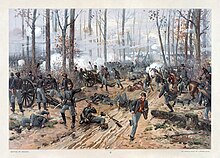
- 6th/7th April: The troops of the Northern States under General Ulysses S. Grant win the two-day Battle of Shiloh . In what was until then the most costly battle of the war, they did not exhaustedly pursue the retreating Confederate army units under Pierre Gustave Toutant Beauregard .
- 29/30 May: In the First Battle of Corinth , Union units under Henry Wager Halleck capture the strategically important railroad junction of Corinth, Mississippi , held by Beauregard's troops.
Iuka-Corinth campaign
- September 19 Battle of Iuka ends in Union victory.
- October 3: The Second Battle of Corinth begins.
- October 4: In the Second Battle of Corinth , Confederate forces are defeated by the Confederate Army in an attempt to take the city that had begun the day before .
- October 5: The battle at Hatchies Bridge also ends in a Union victory, but the Confederate West Tennessee Army under Major General Earl Van Dorn successfully evades capture by Union troops, as on the previous day.
Maneuvers along the Mississippi
- January: The Confederates under Pierre Gustave Toutant Beauregard occupy Island No. 10 in the Mississippi River .
- March 14: The Unionist Mississippi flotilla begins shelling the island.
- April 7: After two Union ironclads manage to pass the island, Union forces under John Pope capture Island No. 10
- April 28 Union Admiral David Glasgow Farragut and his flotilla capture the Confederate city of New Orleans and advance up the Mississippi River to Vicksburg, Mississippi . On the way, the towns of Baton Rouge and Natchez are taken without a fight in early May . However, the first attempt to take Vicksburg fails in May.
- June 6: In the Battle of Memphis , Memphis , Tennessee , is taken by the Union Army of the Tennessee under Ulysses S. Grant and held until the end of the war. A significant contributor to the victory was the United States Ram Fleet . General Grant then arrives at Memphis headquarters.
- November 2 General Grant advances his troops to Vicksburg, now the last Confederate-held town on the Mississippi River. However, by the end of the year, the besieged city has not been taken. The first Vicksburg campaign lasted until March of the following year.
More battles and campaigns in the west
- April 12: In the Andrews Raid , Confederate soldiers hijack a Western and Atlantic Railroad train to cut the line with Chattanooga , Tennessee , which was under siege by the Union Army . The action forms the subject of Buster Keaton's 1926 film The General .
- October 8: The Battle of Perryville , the final battle of the Confederate Heartland Offensive, ultimately benefits neither side. The Confederates finally withdraw from Kentucky .
- December 31: Battle of Stones River begins.
Trans-Mississippi Theater of War
- 7th/8th March: The Southern States under General Earl Van Dorn are defeated by the Northern States under General Samuel Curtis in Arkansas at the Battle of Pea Ridge . The Confederates are forced to abandon northern Arkansas and are no longer able to threaten Missouri . Van Dorn is moved east of the Mississippi with his troops for reinforcements.
- March 26–28: At the Battle of Glorieta Pass , Union troops from the Northern States thwart Confederate forces advancing to the Southwest as part of the New Mexico Campaign .
- March 29 Confederates lose in gunfire at Stanwix Station , Arizona. They retreat to Tucson , evacuate the city and destroy all supplies stashed there. They succeed in delaying the advance of the California Column along the disused Butterfield Overland Mail to Tucson and Mesilla considerably.
- August 10: During the Nueces River massacre , 61 German - Texans who ideologically support the Union cause are caught by Confederate cavalry units on the west bank of the Nueces River while fleeing to Mexico , and 34 of them are shot, some of them , after they have already surrendered.
- October: Union captures Galveston , Texas , from the sea.
Other Events in the Western Territories
- May 20: US President Abraham Lincoln signs the Homestead Act , a law allowing farmers to acquire up to 64 hectares of uncultivated land, aimed at settling the West.
- August 17 After the Bureau of Indian Affairs payments are delayed, starving Sioux ambush and murder five whites in search of food. This is considered the beginning of the Sioux rebellion in Minnesota led by Chief Little Crow (Taoyateduta).
- August 19: Sioux unsuccessfully attack the city of New Ulm , Minnesota. After an equally unsuccessful attack on Fort Ridgely on August 20-22, the Indians reappear outside the town. Far outnumbered, they completely encircle the city, but again cannot conquer it. The city is finally evacuated on August 25, after heavy casualties among the defenders, with little ammunition and food left. Around 2,000 people escape to Mankato , 30 miles to the east .
- September: Abraham Lincoln dispatches Major General John Pope and Colonel Henry Hastings Sibley , former Minnesota governor, to quell the insurgency west.
- September 2 Indians defeat a small detachment under Major Joseph R. Brown at Birch Coulee.
- September 23 Colonel Sibley decisively defeats the Sioux at Wood Lake. Little Crow manages to escape with some warriors, but most of the Sioux give up the fight and release their captives.
- Six weeks later, 392 Dakota are brought before military tribunals. In trials, some of which last only five minutes, 303 of them are sentenced to death for rape and murder. However, there was protest, and President Lincoln commuted most of the death sentences to imprisonment. He only confirms the verdicts of those found guilty of raping and murdering civilians.
- December 26: The largest mass execution in United States history to date takes place in Mankato . 38 Dakota warriors sentenced to death are publicly hanged after the failed Sioux uprising .
- In the course of the uprising, the US government decides to dissolve the reservation. All contracts with the Dakota are declared null and void, and the state of Minnesota is offering a $25 bounty for each scalp of a Dakota found free. The captured members of the tribe, about 1,300 to 1,700 people, are taken to Nebraska and South Dakota on the newly established Crow Creek Reservation , including some pro-white groups of Sioux.
Canada
- July 19: In British North America , at the height of the Gold Rush, the Stikine Territory is separated from the Northwest Territory and thereby removed from the Hudson's Bay Company . It falls under the jurisdiction of James Douglas , the governor of the Crown Colony of British Columbia .
Mexico
- January 6th to 8th: After Spanish troops arrived in Veracruz in December , English and French ships also land in Mexico.
- January 25: The Republican government of Benito Juárez enacts a law making any armed resistance to the state punishable by death.
- March 5: French General Charles Ferdinand Latrille Lorencez lands in Mexico and assumes supreme command of the invading forces.
- May 5: One of Emperor Napoleon III. French army corps sent under General Lorencez is defeated in the Battle of Puebla by the Mexican army under the command of Ignacio Zaragoza . The cavalry under Porfirio Díaz played an important part in the Mexican victory. The Battle of Puebla is the most important Mexican victory in the early days of the French intervention in Mexico and this day - Cinco de Mayo - is celebrated annually in Mexico to this day. The French under General Lorencez withdraw to Orizaba.
- May 18: In the Battle of Barranca Seca , the French troops are victorious together with reactionary Mexican units under Leonardo Márquez .
- June 14: The French defeat the Mexican troops who have carelessly pursued them to Orizaba .
- September 8 General Zaragoza dies of typhus.
- October 1: Élie-Frédéric Forey replaces General Lorencez as commander-in-chief of French troops. He conquered Tampico that fall, on October 23, and Xalapa , the capital of the state of Veracruz, on December 12 .
Honduras
José Santos Guardiola , President of Honduras since 1856 , is assassinated by his bodyguard on January 11. With his deputy Victoriano Castellanos Cortés in El Salvador, Parliament elected MP José Francisco Montes Fonseca as President. On February 4, Castellanos Cortés takes office as President of Honduras and convenes a Constituent Assembly. On May 8, the latter published Decree No. 3 , in which the designation Republic of Honduras was used for the first time. However, due to his rapidly deteriorating health, he handed the post back to Montes Fonseca on December 4th. Victoriano Castellanos Cortés dies a few days later on December 11th.
South America
- September 10: Following the death of Carlos Antonio López , his eldest son , Francisco Solano López , hitherto Minister of War in his father's cabinet, assumes power as President of Paraguay . The step is subsequently legitimized by the country's Congress. Francisco's brother Venancio becomes the new Minister of War. A personality cult is built up around the president, who reigns with absolute power.
- October 5 Liberal Bartolomé Miter is elected President of Argentina in the first national elections . He will take office on October 12.
- November: The civil war in Colombia , which has been going on since 1860 , ends. The following year, the Granada Confederation becomes the United States of Colombia .
Prussia
- January: Liberal Wilhelm Grabow becomes President of the Prussian House of Representatives .
- March 12: The cabinet of Prime Minister Karl Anton Prince von Hohenzollern-Sigmaringen resigns and Parliament is dissolved. On March 17, Adolf zu Hohenlohe-Ingelfingen becomes the new prime minister. Conservative forces are primarily represented in his cabinet. This ends the so-called New Era in Prussia .
- May 6: The liberal German Progressive Party achieves an absolute majority in the elections to the Prussian House of Representatives. Prime Minister Adolf zu Hohenlohe-Ingelfingen submits his resignation, which King Wilhelm I does not accept.
- 22./23. September: Otto von Bismarck is appointed Prime Minister during the Prussian constitutional conflict . His cabinet includes, among others, Albrecht von Roon , Carl von Bodelschwingh , Heinrich Friedrich von Itzenplitz and Gustav von Jagow .
- September 30: In a speech to the budget commission of the House of Representatives, Prime Minister Otto von Bismarck expresses his conviction that iron and blood decide the big questions of the time. He wants to push through an army reform.
- October 13: With his first official act, Bismarck dissolves the Prussian House of Representatives and proclaims a “budgetless regime”, turning the army conflict into a concrete constitutional conflict.
- December: Interior Minister Gustav von Jagow resigns because he does not agree with Bismarck's budgetless regime.
Other events in the German Confederation
- September 26: Prince Johann II signs the first constitution in the history of Liechtenstein . The state parliament thus becomes the representative body of the people . Of the 15 deputies, 3 are appointed by the prince, 12 are elected by indirect elections via electors . In the same year, the first newspaper appears in the principality.
- October 26: The German Reform Association , which works as a counterpart to the German National Association founded in 1859 for the Greater German solution to the German question , is founded. The Liberal Oskar von Wydenbrugk is in charge .
- With the introduction of so-called district offices , the separation of judiciary and administration in the Kingdom of Bavaria takes place . The regional courts are thus only purely judicial bodies.
Switzerland/France
- 1 January: Jakob Stämpfli becomes President of the Swiss Confederation for the third time .
After French troops marched into the Dappental last year , the status of the Dappental was clarified in the form of an area swap covering seven square kilometers. France gets the western part of the valley and the road it built. In replacement of this, Switzerland is given areas from the junction of the roads of Saint-Cergue and the Col de la Faucille (the strategic road) along the slope of the Noirmont to the existing border with the Vallée de Joux . Article I of the State Treaty also designates a strip of land east of the strategic road at an average width of approximately 500 Swiss feet or 150 meters from French territory. Furthermore, the contract stipulates that no military installations may be built in the area of the Dappental, and that those living in the exchanged territories may freely choose their citizenship and remain resident in the place. In addition, Switzerland is given the right to use the road from the Vallée de Joux via the French Bois-d'Amont to La Cure free of charge and without customs duties.
Balkans
- June 20: Romanian Prime Minister Barbu Catargiu is assassinated in the new capital, Bucharest , four months after taking office . The background of the fact is never cleared up. The previous foreign minister, Apostol Arsache , will be his interim successor . He will be replaced by Nicolae Crețulescu on June 24th .
- October 24: A military coup deposes King Otto I of Greece and forces him out of the country. Dimitrios Voulgaris replaces Gennaios Kolokotronis as prime minister and forms a provisional government.
Other events in Europe
- 1 February: The Van Zuylen van Nijevelt/Van Heemstra cabinet under Prime Minister Schelto van Heemstra , which has been in power in the Netherlands since 1861 , is replaced by a liberal cabinet under Johan Rudolf Thorbecke , who begins a second term in office.
- August 29: Risorgimento : The Piedmontese troops win the battle of the Aspromonte , a massif in Calabria , against the volunteer associations of Giuseppe Garibaldi . He is injured in battle.
- 6 October: After a wedding by proxy on 27 September in Turin, the Portuguese King Louis I marries Princess Maria Pia of Savoy in Lisbon .
Africa
- March 5: Lagos , annexed the previous year, is declared a crown colony by Great Britain .
Japan
- May 29: At the Teradaya Incident in Fushimi , Satsuma samurai quell a rebellion in their own ranks.
- September 14: During the Namamugi Incident , several British citizens are attacked by Japanese samurai for disrespect to their daimyo , killing one and injuring the others.
- Bakumatsu : The practice of sankin kōtai , the requirement for daimyō to appear regularly (temporal modalities varied) in the capital Edo and give account to the shogun , is abolished. This also eliminates the obligation to maintain proper residences in Edo and to let their families live there as hostages all year round.
China
- April: Muslim Dungan uprisings begin in northwestern China , triggered by an attack by Taiping rebels on Shaanxi, including Xi'an .
India
- July/August: In quick succession, three newly established Supreme Courts in British India begin their work. All three were inaugurated by Letters Patents from Queen Victoria . They are:
- Calcutta High Court for the Presidency of Bengal on July 1, 1862
- Bombay High Court for the Bombay Presidency on August 14, 1862
- Madras High Court for the Madras Presidency on August 15, 1862
Cochinchina
- June 5: Faced with French military successes and renewed peasant unrest in Tongking , the Vietnamese government in Huế is forced to sign a treaty with France ceding three northern provinces of Cochinchina to France. She also undertakes to pay reparations and assures the French the right to proselytize, to sail on the Mekong and to trade in some port cities. In the Treaty of Saigon , the city becomes the capital of the French colony of Cochinchina .
Australia
Scotsman William Landsborough sets out February 10 with the six-person Queensland Relief Expedition in search of the Burke and Wills expedition south from the Gulf of Carpentaria . It follows the Flinders River for some time , but finds itself pushed too far to the east and orients itself towards Cooper's Creek . On May 21, he arrives at a farm near Cunnamulla and finally learns of the fate of Robert O'Hara Burke and William John Wills . Landsborough set off again two days later with renewed supplies, finally reaching Melbourne in October via the Darling River and Menindee , 300 km away . He is the first white person to cross the Australian continent from north to south. None of the expedition members were harmed during the journey. In November, Landsborough was awarded a gold watch by the Royal Geographical Society for discovering a walkable north-south route through Australia .
New Zealand
- July 7th: Provisionally, a parliamentary session is held for the first time in what later becomes the capital , Wellington .
- August 6: After a successful motion of no confidence in William Fox , Alfred Domett is offered the post of Prime Minister of New Zealand , which he accepts. However, he soon comes under fire himself.
Oceania
- Tonga receives its national coat of arms .
business
world exhibition
- 1 May: After 11 years, a world exhibition takes place in London at the gardens of the Royal Horticultural Society in South Kensington . The Great London Exposition runs until November 1st. The organizer is the Royal Society of Arts, Manufactures and Trade .
taxes and finance
- February 25: The US Treasury Department issues greenbacks , a form of fiat money , with the first Legal Tender Act to finance the Civil War .
- August 24: The Italian lira , introduced the previous year, becomes the sole means of payment and replaces all previous currencies in the territories united to form the Kingdom of Italy .
- With the Revenue Act of 1862 , a tax progression for the income tax introduced in the previous year with the Revenue Act of 1861 is decided in the United States . At the same time, the Lincoln administration decides to introduce a new agency to collect income taxes.
start-ups
- January 21: After years of wandering around, the qualified locksmith Adam Opel founds a sewing machine factory in his hometown of Rüsselsheim , from which the Opel company develops.
- February 4: Facundo Bacardí buys a small rum distillery at Calle Matadero N° 5 in Santiago de Cuba and founds the company Bacardi & Ca.
- April 5: Austrian merchant Julius Meinl establishes his first shop at Fleischmarkt in Vienna . In the food trade, only green coffee beans are initially offered, later also freshly roasted coffee .
- October 22: The Neustadt-Dürkheimer Eisenbahn-Gesellschaft is founded. Based on an agreement with the Palatinate Ludwig Railway Company dated January 25 and the concession granted on August 28, this company is to build a local railway between the towns of Neustadt an der Weinstraße and Dürkheim .
- 13 December: Germany's first mortgage bank , Deutsche Hypothekenbank , is founded in Meiningen .
- The industrialists Salomon Volkart , Heinrich Rieter , Heinrich Sulzer-Steiner and Johann Jakob Sulzer found the Bank in Winterthur with seed capital of five million Swiss francs .
- Georg Adam Scheid and Michael Markowitsch found OHG Markowitsch & Scheid in Vienna , a predecessor of today's Ögussa .
- The Standard Bank of British South Africa is formed.
- The American Shipmasters' Association is founded.
- In New Orleans , the Café du Monde is founded as a small street café.
traffic
- January 5: The first part of the Pavia–Torreberetti railway line in Italy opens. The terminus in Pavia will be reached on May 10th. At the same time, the Rogoredo-Pavia railway line, which branches off the Milano-Bologna railway line at Milano Rogoredo station , is also being completed.
- March 1: The Bergisch-Märkische Eisenbahn-Gesellschaft opens the section of the railway line through the Ruhr valley from Bochum via Steele, Essen, Mülheim (Ruhr) and Styrum to Oberhausen, a few weeks later on May 1 with the section from Styrum to Duisburg BME the route in the west will be completed for the time being. In the same year, the line was then extended from Langendreer in an easterly direction to Dortmund and opened to passenger traffic on October 5th.
- 19 June: Switzerland 's first horse -drawn tram, the Rösslitram , runs in Geneva . The Geneva tram does not go through the actual city center, but connects the suburb of Carouge with the Place Neuve on the edge of the city center. The carriages of the first Swiss trams were relatively heavy and therefore had to be pulled by two horses.
- 23 June: The world's first narrow- gauge railway in Cape gauge goes into operation on the Hamar-Grundset line in Norway . It was designed by railway pioneer Carl Abraham Pihl .
- 1 July: The Waverly Line extension through the Scottish Borders from Hawick to Carlisle opens.
- July 1: The US Military Railroad is established by order of the US Congress to open up the western United States . It will receive around 12 million acres of land and $27 million in government bonds.
- 28 July: The Great Eastern Railway is formed by merging the Eastern Counties Railway with several smaller railway companies in East Anglia .
- August 4: The first section of the Kocher Railway from Schwäbisch Hall to Heilbronn , which was built under the supervision of Carl Julius Abel , is opened by the Royal Württemberg State Railways .
- October 23: The first part of the Odenwald Railway in the Grand Duchy of Baden from Heidelberg via Neckargemünd, Meckesheim, Neckarbischofsheim, Aglasterhausen and Neckarelz to Mosbach is opened.
- December: The last section of the Petersburg-Warsaw railway , which has been under construction since 1851 , is completed and opened.
- The railway line Vegesack-Bremen and the railway line Bremen-Bremerhaven are opened.
Others
- July 18: The Hobrecht plan for the development of the area around Berlin is approved.
- After the swill milk scandal of 1858, the first regulatory measures in milk production were decided in New York.
science and technology
Africa research
- January: Alexine Tinne sets out from Cairo up the Nile to meet John Hanning Speke . Together they then want to search for the source of the Nile . When Speke does not arrive at the agreed meeting point, Tinne sets off alone with her people. She ventures overland into the little-explored regions of the Congo , arriving in Gondokoro on September 30th . However, the expedition lacks porters and food, and after several bouts of malaria , Tinne abandons the journey and soon sets off on the return journey. On this trip she encounters slave caravans directly for the first time, documents this, does not shy away from messing with the slave traders and buys several people free, whom she offers to join her entourage. As soon as she returns to Cairo, she begins planning to explore the Gazelle River.
- February 10: After writing down his travel reports, Karl Moritz von Beurmann also decides to go in search of Eduard Vogel and sets off south from Tripoli .
- April 4: Theodor von Heuglin and Hermann Steudner establish friendly relations with the Abyssinian Emperor Theodor II . As a result, Heuglin was no longer in charge of the expedition to search for Eduard Vogel. Werner Munzinger , who has been in Khartoum since March 1 with a split-off part of the expedition , is appointed as the new leader.
- Karl Klaus von der Decken returns to Kilimanjaro after a year to attempt the first ascent by a European. However, at an altitude of around 4,200 meters he had to give up due to snowfall. He then explores the course of the Pangani River with his partner Otto Kersten .
- December: Samuel White Baker and Barbara Szász set off from Khartoum with a caravan to explore the course of the White Nile .
archeology
- US antiquities dealer Edwin Smith acquires a scroll of papyrus at a market in Luxor . The ancient Egyptian medical text, later named Papyrus Edwin Smith , is one of the oldest written documents of medical healing processes.
astronomy
- January 31 Alvan Graham Clark discovers Sirius B , a companion of Sirius - later identified as a white dwarf .
- March 27: In Zurich, the foundation stone is laid for the Swiss Federal Observatory designed by Gottfried Semper , which will become famous for its research into sunspots . It is completed in 1864.
- May 23: The German astronomer Eduard Schönfeld finds the spiral galaxy later recorded as NGC 4383 in the constellation Haar der Berenike .
- July 16: Lewis Swift discovers a new comet while surveying the sky . Three days later, independent of Swift , Horace Parnell Tuttle encounters the same celestial phenomenon.
- The German-Danish astronomer Heinrich Louis d'Arrest discovered several galaxies in the constellation Pisces in the course of his work at the University of Copenhagen : NGC 403 (August 29), NGC 186 (September 23) and NGC 199 (September 24).
List of asteroids discovered in 1862
| No. and name |
diameter (km) |
date of discovery | explorer |
|---|---|---|---|
| (73) Clytia | 44.4 | 7th of April | Horace Parnell Tuttle |
| (74) Galatea | 118.7 | 29th August | Ernst Wilhelm Leberecht Temple |
| (75) Eurydice | 55.9 | September 22nd | Christian Heinrich Friedrich Peters |
| (76) Freia | 183.7 | October 21 | Henry Louis d'Arrest |
| (77) Frigga | 669.3 | November 12th | Christian Heinrich Friedrich Peters |
biology
- November 10: British biologist and educational organizer Thomas Henry Huxley gives the first of his ten-part lecture series On Our Knowledge of the Causes of Phenomena in Organic Nature , at the Geological Museum in London's Jermyn Street , based on the ideas of Charles Darwin's work published in late 1859 to popularize The Origin of Species . Among the audience are also Karl Marx and Wilhelm Liebknecht .
- Ernst Haeckel writes a monograph on radiolarians .
- The first description of the Reunion Consecration by the French ornithologist Jules Verreaux is published in Louis Maillard 's Notes sur l'Île de la Réunion (Bourbon) .
- The Augustinian monk Gregor Mendel founds the Natural Researchers Association Brno with friends from the area .
musicology
- Ludwig von Köchel publishes the first edition of the Köchel Index, a catalog raisonné of the compositions of Wolfgang Amadeus Mozart .
Teaching and Research
- May 2: California State Normal School – now San Jose State University – is founded in California .
- July 1: The State Library of Russia is established as Moscow's first free and public library under the name Library of Moscow Public Museum and Rumyantsev Museum , or Rumyantsev Library for short, in the Pashkov House .
- At the suggestion of his general manager Matthias Reischle , the liqueur manufacturer Anton Riemerschmid founds a business school for women in Munich , the first business school for girls in Germany. Reischle becomes the first director and, like most other members of the teaching staff, waives payment for his work at the school.
- The University of South Dakota is founded in Vermillion in the Dakota Territory .
- The Riga Polytechnic is established.
- The Association for the Swiss German Dictionary was founded for the first time on the initiative of the Antiquarian Society in Zurich . The first editor-in-chief is Friedrich Staub .
surveying
- The Royal Saxon Triangulation begins, a state survey carried out in the years 1862 to 1890 on the territory of the Kingdom of Saxony and the creation of a trigonometric network. The aim is to record the national territory scientifically and geodetically and to provide the basis for a detailed land survey and a modern map series by establishing permanently marked reference points . The Grossenhainer baseline is used as the benchmark .
Culture
| Culture | |
|---|---|
Visual arts
- May 20: The Museum of Fine Arts in Warsaw opens.
- In Music in the Tuileries Garden , Édouard Manet portrays himself as part of bourgeois Parisian society along with the painters Albert de Balleroy and Henri Fantin-Latour , the writers Zacharie Astruc , Théophile Gautier and Charles Baudelaire , and the composer Jacques Offenbach reviews and remains unsaleable for over 20 years.
- Édouard Manet founded the Societé des Aquafortistes together with Felix Bracquemond, Henri Fantin-Latour, Alphonse Legros , Johan Barthold Jongkind and Augustin Théodule Ribot , inspired by the editor Alfred Cadart and the photographer Félix Chevalier . This artists' association has set itself the goal of promoting the art of etching . Manet made numerous etchings based on his paintings, especially in the 1860s.
- Eastman Johnson produces A Ride for Liberty — The Fugitive Slaves in oil on canvas .
literature
- 11 February: Julia Ward Howe publishes the poem The Battle Hymn of the Republic in The Atlantic Monthly .
- March: The novel Im Schloß by Theodor Storm is printed for the first time in issues 10 to 12 of the magazine Die Gartenlaube . In the politically and socially confessional and religiously critical narrative, Storm advocates the abolition of class differences.
- April 3rd/15th May: Victor Hugo publishes the monumental novel Les Misérables in five volumes. The criticism is divided, but the work is a financial success.
- July 4: While on a boat trip on the Thames, Charles Lutwidge Dodgson tells sisters Alice, Edith and Lorina Lidell a story that would later become known as Alice in Wonderland .
- The Swiss humanist Henri Dunant publishes the work A memory of Solferino ( Un souvenir de Solférino ) in French at his own expense and sends it to political and military leaders. Within a few years it is translated into eleven languages.
- End of the year: Gustave Flaubert's novel Salambo appears.
music and theatre
- 7 January: Earlier Relationships , a one-act farce with vocals by Johann Nestroy to music by Anton M. Storch , premieres at Vienna 's Quai-Theater .
- 1 February: The world premiere of the "Native American carnival burlesque" Chief Evening Wind or The Ghastly Feast by Johann Nestroy with music by Jacques Offenbach takes place at the Quai Theater in Vienna. It is the last play written by Nestroy. He dies in Graz on May 25 at the age of 60. His last role is the starring role of Knieriem in The Evil Spirit Lumpacivagabundus .
- February: The fairy tale singspiel Hansel and Gretel by Georg Kremplsetzer is premiered in the Odeon concert hall in Munich. In his libretto , Wilhelm Busch deviates greatly from the original by the Brothers Grimm .
- April 19: The Théâtre du Châtelet in Paris, built by Gabriel Davioud on behalf of Baron Haussmann on the Place du Châtelet , opens in the presence of the Empress Eugénie with a performance of Rothomago by d'Ennery, Clairville and Monnier.
- 26 April: The premiere of the operetta Die Kartenschlägerin by Franz von Suppè , originally written for the Theater an der Wien and adapted for the Theater am Franz-Josefs-Kai in Vienna, is unsuccessful.
- 1 May: Delegates from 106 clubs found the Franconian Singers ' Association in Bamberg .
- August 2: Datterich , a Darmstadt local posse in Hessian dialect by Ernst Elias Niebergall , is premiered in Bessungen almost 20 years after the author's death.
- August 9: On the occasion of the opening of the Baden-Baden Theater , the two-act opera Béatrice et Bénédict by Hector Berlioz is premiered. The libretto , freely adapted from William Shakespeare's Much Ado About Nothing , was written by the composer himself.
- September 21: Carl Gerster is in charge of founding the German Singers ' Association in Coburg , the world's largest association of amateur choirs.
- October 25: The operetta Ten Girls and No Man by Franz von Suppè has its world premiere at the Theater am Franz-Josefs-Kai in Vienna. The libretto was written by Friedrich Wilhelm Riese under the pseudonym Wilhelm Friedrich.
- November 10: The opera La forza del destino by Giuseppe Verdi with the libretto by Francesco Maria Piave based on the template Don Álvaro o la fuerza del sino by the Spanish Duke Ángel de Saavedra is premiered in Saint Petersburg and received by the audience with exuberant enthusiasm.
- George Frederick Root authors the song Battle Cry of Freedom . Originally intended for Union use, the song became so popular that it was adapted for the Confederacy and sung in the Southern States.
Others
- June 17: Württemberg 's King Wilhelm I approves the establishment of a state collection for patriotic art and antiquity monuments in Stuttgart – today's Württemberg State Museum .
- August 21: The Wiener Stadtpark , designed by the landscape painter Joseph Sellény and laid out by the city gardener Rudolph Siebeck on the site of the shortly before demolished Wasserglacis in the style of an English landscape park , is opened as the second Volksgarten in Vienna .
- October 6: Australia 's first zoo opens in Melbourne .
- November 15: A city beautification committee is founded in Salzburg by 26 people .
- Peter Karlowitsch von Uslar develops the Abkhazian alphabet .
society
- June 21: At a board meeting of the Natural Science Association of Elberfeld and Barmen , the Wupperthal Association for the Protection of Animals is founded under the leadership of Johann Carl Fuhlrott . As of December 4, the new association already has 260 members. Through targeted public relations, Fuhlrott succeeds in raising awareness of ecological relationships in the population.
- September 23: Lev Nikolaevich Tolstoy marries Sofya Andreevna Behrs . A little later he begins writing his epic novel War and Peace .
- 15 December: The first philatelic journal , The Monthly Advertiser , appears in England . The first stamp albums appear in Paris in the same year .
- Today's Niederschönenfeld correctional facility in Bavaria is the first youth prison in Germany to be built for male prisoners between the ages of 12 and 18.
- The Irish Water Spaniel is recognized as a dog breed by The Kennel Club .
- The Ghost Club is founded in London . Among the earliest members of the organization, whose purpose is ghost hunting and research into paranormal phenomena such as specters and hauntings , were numerous academics and clergy from the University of Cambridge , in addition to Charles Dickens .
religion
- January 6: Zygmunt Szczęsny Feliński is appointed the new Archbishop of Warsaw and ordained in St. Petersburg on January 26. Like his predecessor Antoni Melchior Fijałkowski , who died the previous year, he became a patriotic figure in divided Poland.
- March 3: The Rheinau monastery in the canton of Zurich is dissolved by decision of the cantonal council. The monastery archive is incorporated into the State Archive of the Canton of Zurich .
- 7 April: The previous Archbishop of Udine, Giuseppe Luigi Trevisanato , becomes Patriarch of Venice , succeeding Angelo Ramazzotti , who died the previous year .
- April 8: With the encyclical Amantissimus , Pope Pius IX. to the bishops of the Eastern Church and reminds them of their unity with the Catholic Church.
- June 12: The Franciscan Friars of the Holy Cross are founded as a congregation under pontifical rights . They originate from the residential community Frommer Handwerker founded by Peter Wirth .
- September 28: The Archeparchy of Baghdad of the Syrians is founded.
- November 13: The market church built by Carl Boos on the Schloßplatz in Wiesbaden is inaugurated.
- 13 December: Catholic Sorbs found the Cyrill Methodius Association .
- Dimitrios II becomes Pope of the Coptic Church , succeeding Kirellos IV , who died the previous year .

- Sabina Schneider and three other Benedictine nuns jointly lease the former ancestral seat of the Lords of Ofteringen and found the Marienburg monastery .
disasters
- March 12: The steamboat Brother Jonathan , coming from San Francisco, docks in Victoria , British Columbia , triggering the smallpox epidemic on the Pacific coast of North America . In the course of a year, smallpox kills around half of the total indigenous population, around 14,000 people.
- July 27: A fire aboard the American paddle steamer Golden Gate off the Mexican coast kills 204 of the 338 passengers and crew on board. The ship runs aground and breaks apart.
Sports
- January 22: A skiing event is held in Trysil , Norway, which includes a ski jumping competition for the first time .
- February 12: Miroslav Tyrš founds the first Slavic national gymnastics movement Sokol in Prague based on the model of the German gymnastics movement .
- November: Notts County Football Club is formed.
- November 19: The Austrian Alpine Club is founded at the suggestion of the students Paul Grohmann , Edmund von Mojsisovics and Guido von Sommaruga as the first mountaineering association on the European mainland and thus the second oldest in the world after the British Alpine Club .
- 29 December: Sheffield FC and Hallam FC play their first football match at Bramall Lane Stadium in Sheffield , the oldest football ground still in use in the world.
Historical maps and views
Born
January February
- January 2: Mikhail von Dolivo-Dobrovolsky , Russian engineer (died 1919)
- January 3: Max Littmann , German architect (died 1931)
- January 3: Heinrich August Meißner , German engineer and Ottoman pasha (died 1940)
- January 3 Matthew Nathan , British officer and colonial official (d. 1939)
- January 4: Louis F. Hart , American politician (died 1929)
- January 5: Inès de Bourgoing , French nurse and President of the French Red Cross, first woman to be awarded the Grand Cross of the Legion of Honor († 1953)
- January 6: August Oetker , German inventor of ready-to-use baking powder (d. 1918)
- January 9: Maurice Arthus , French physiologist (died 1945)
- January 9: Agnes Bluhm , German doctor (died 1943)
- January 12: John George Adami , British-Canadian pathologist (d. 1926)
- January 14 Rosalía Abreu , Cuban animal breeder and behaviorist (d. 1930)
- January 15 – Loïe Fuller , American burlesque actress, singer (d. 1928)
- January 18: Anna Jäger , Austrian-German opera singer († 1937)
- January 20: Xaver Terofal , German actor (died 1940)
- January 20: Carl von Tubeuf , German plant pathologist and professor (died 1941)
- January 21: Ewald Müller , German teacher, local poet and local researcher († 1932)
- January 23: Anton Delbrück , German psychiatrist (died 1944)
- January 23: David Hilbert , German mathematician (died 1943)
- January 23 – Ovington Weller , American politician (died 1947)
- January 24: Alfonso of Bavaria , Prince of Bavaria (died 1933)
- January 24 – Edith Wharton , American novelist (d. 1937)
- January 29: Frederick Delius , English composer (died 1934)
- January 30: Alfred Stabell , Norwegian marksman (d. 1942)
- February 1: Anastasius Nordenholz , German-Argentinian economic philosopher (died 1953)
- February 5: Aleksander Kakowski , Archbishop of Warsaw and Cardinal (died 1938)
- February 5: Felipe Villanueva , Mexican composer (d. 1893)
- February 5 Oskar Herrfurth , German painter and illustrator (died 1934)
- February 6 – Rafaela Serrano Rodríguez , Cuban pianist and music teacher of Spanish origin (d. 1938)
- February 7: Horace F. Graham , American politician (died 1941)
- February 7 Edward Granville Browne , British orientalist (died 1926)
- February 8 – Károly Ferenczy Hungarian Impressionist painter (died 1917)
- February 10: Marius Anton von Attems-Heiligenkreuz , Austrian Imperial and Royal governor in the Kingdom of Dalmatia and Privy Councilor († 1947)
- February 12 Brito Camacho , Portuguese politician (died 1934)
- February 14: Agnes Pockels , German physicist and chemist (d. 1935)
- February 17: Mori Ōgai , Japanese physician, novelist and translator († 1922)
- February 21 Emiliana Concha de Ossa , South American artist model and muse (d. 1905)
- February 22: Louise Dumont , German actress and theater director (d. 1932)
- February 24: Harry Puder , German officer (died 1933)
- February 27: Sophie Countess Attems-Heiligenkreuz , Austrian writer († 1937)
- February 27 Hamilton Fish Kean , American politician (died 1941)
- February 28: Rudolf Huch , German lawyer and writer (died 1943)
March April
- March 4: Robert Emden , Swiss physicist and astrophysicist (d. 1940)
- March 4: Norman Gale , English poet (died 1942)
- March 4 George H. Prouty , American politician (d. 1918)
- March 5: Siegbert Tarrasch , German chess grandmaster (died 1934)
- March 7: René Bohn , German chemist (died 1922)
- March 7: Josef Strzygowski , Polish art historian (died 1941)
- March 12: Alfredo Peri-Morosini , Swiss Catholic Bishop (died 1931)
- March 12: Richard Skowronnek , German journalist and writer (died 1932)
- March 13: Wilhelm Weigand , German poet and writer (died 1949)
- March 14: Emil Beurmann , Swiss writer, poet, draftsman and painter († 1951)
- March 17: Silvio Gesell , German merchant, financial theorist (died 1930)
- March 17: Heinrich Vogelsang , German merchant and consul (died 1914)
- March 20 Adolf Braun , Austro-German social democratic politician and journalist (died 1929)
- March 25: Richard Cornelius Kukula , Austrian classical scholar († 1919)
- March 25 George Sutherland , American politician and judge (d. 1942)
- March 28: Aristide Briand , French Prime Minister and Foreign Minister († 1932)
- March 29: Carl Busch , American composer (d. 1943)
- March 30 Wilhelm Bode , German teacher and writer, anti-alcoholic activist (d. 1922)
- March 31: Claude A. Swanson , American politician (d. 1939)
- April 2 – Nicholas Murray Butler , American philosopher and publicist, winner of the Nobel Peace Prize (died 1947)
- April 2 William Bauchop Wilson , American politician (died 1934)
- April 4 Wilhelm Altmann , German music historian and librarian (died 1951)
- April 4: Max Crone , German theologian and writer (died 1939)
- April 7: William Haselden Ellerbe , American politician (died 1899)
- April 8: August Aschinger , German restaurateur (died 1911)
- April 9: Teuvo Pakkala , Finnish writer (died 1925)
- April 11: Heinrich Cunow , German politician (died 1936)
- April 11: Charles Evans Hughes , American politician (died 1948)
- April 11: Thomas Kearns , American politician (died 1918)
- April 12: Jean-Baptiste Reboul , French chef (d. 1926)
- April 13: Maximilian Modde , German painter (died 1933)
- April 14 Martin Grove Brumbaugh , American politician (died 1930)
- April 14: Pyotr Stolypin , Russian politician (died 1911)
- April 20: Clemens Pfau , German local historian (died 1946)
- April 24 Nathaniel B. Dial , American politician (d. 1940)
- April 24 Tomitaro Makino , Japanese botanist (d. 1957)
- April 26: Friedrich Austerlitz , Austrian journalist and politician (died 1931)
- April 29: Carl Friedemann , Swiss composer and conductor (d. 1952)
May June
- May 2: Maurice Emmanuel , French composer (died 1938)
- 2 May: Heinrich Kraus von Elislago , Austrian Field Marshal Lieutenant († 1932)
- May 6: Oscar Underwood , American politician (died 1929)
- May 8: Hugo Erdmann , German chemist (died 1910)
- May 11 Albert Arnstadt , German politician (died 1947)
- May 11: Franklin S. Billings , American politician (d. 1935)
- May 12: Oskar Freiwirth-Lützow , German painter (died 1925)
- May 12: Johannes Poggenburg , German Catholic bishop (died 1933)
- May 15: Cassius Keyser , American mathematician (died 1947)
- May 15 Nils Posse , Swedish physical education teacher (died 1895)
- May 15: Arthur Schnitzler , Austrian storyteller and playwright (died 1931)
- May 16 Margaret Fountaine , British lepidopterist (d. 1940)
- May 16 Andrieus A. Jones , American politician (died 1927)
- May 18: Hans von Ramsay , German officer and explorer (died 1938)
- May 18: Theodor Scheinpflug , German-Baltic pastor and Protestant martyr (died 1919)
- May 18 Albert von Schrenck-Notzing , German physician and parapsychologist (died 1929)
- May 19: João do Canto e Castro , Portuguese admiral and president (died 1934)
- May 21: Gustav Eichhorn , German physician and prehistorian († 1929)
- May 23 Hermann Gunkel , German Protestant theologian (died 1932)
- May 23: Hermann Obrist , German-Swiss sculptor and co-founder of Art Nouveau († 1927)
- May 27: Feliksa Kozłowska , Polish nun (died 1921)
- May 28 Theodor Fischer , German architect and urban planner (died 1938)
- May 28 Henry Slocum , American tennis player (d. 1949)
- May 30: Anton Ažbe , Austrian painter of Slovene origin (died 1905)
- June 2: Julius Tafel , German chemist (died 1918)
- June 3: Humfrey Anger , Canadian organist, composer, conductor and music teacher (d. 1913)
- June 4: Teresa Claramunt , Spanish feminist, anarchist and syndicalist (died 1931)
- June 4: Camille Decoppet , Swiss politician (died 1925)
- June 5: Allvar Gullstrand , Swedish physician, Nobel Prize winner (died 1930)
- June 5: Ernst Seidler von Moistenegg , Austrian lawyer, university professor, politician and Imperial Prime Minister († 1931)
- June 6: Leopold Armbruster , German sculptor (died 1936)
- June 7: Felix von Arnim , Prussian officer and chamberlain († 1919)
- June 7: Kauppis-Heikki , Finnish writer (died 1920)
- June 7: Philipp Lenard , German physicist and Nobel Prize winner (died 1947)
- June 8: David Ogden Watkins , American politician (died 1938)
- June 9: Herbert Baker , British architect (died 1946)
- June 10: Alfons Maria Augner , Swiss Benedictine monk (died 1938)
- June 12 Wilhelm Meyer-Förster , German writer (died 1934)
- June 14: John Joseph Glennon , Archbishop of St. Louis and Cardinal (d. 1946)
- June 15: Otto Wiener , German physicist (died 1927)
- June 16 Len Small , American politician (died 1936)
- June 18 Otto Immisch , German classical scholar (died 1936)
- June 19: Leo von Dobschütz , Prussian Major General († 1934)
- June 21: Friedrich Wilhelm Franke , German organist (died 1932)
- June 21: Damrong Rajanubhab , Minister of the Interior of Thailand, archaeologist (d. 1943)
- June 21: Henry Holden Huss , American composer (d. 1953)
- June 21: Johannes Schlaf , German playwright, storyteller and translator († 1941)
- June 25: Johannes von Hieber , liberal politician and state president in Württemberg († 1951)
- June 27: Hanka Petzold , Norwegian-German singer, pianist and music teacher in Japan († 1937)
- June 27: Johann Puch , Austrian engineer and industrialist (died 1914)
July August
- July 1 Besim Ömer Akalın , Turkish professor and politician (died 1940)
- July 2: William Henry Bragg , English physicist and Nobel laureate (d. 1942)
- July 2 Christopher Cradock , British Rear Admiral (died 1914)
- July 3 Bolesława Maria Lament , Polish nun, founder and blessed (died 1946)
- July 4: Walter L. Fisher , American politician (died 1935)
- July 5: Horatio Caro , English chess player (died 1920)
- July 9: Carl Thiel , German organist, church musician and professor of music († 1939)
- July 10: August Wilhelm Andernach , German manufacturer, large landowner and alpinist († 1942)
- July 11: Liza Lehmann , English composer, singer and pianist (d. 1918)
- July 12: Hermann Conradi , German writer (died 1890)
- July 14: Gustav Klimt , Austrian painter (died 1918)
- July 15 Frank P. Flint , American politician (died 1929)
- July 15 Ludwig Fulda , German scholar, philosopher and author (died 1939)
- July 17: Oscar Levertin , Swedish writer (died 1906)
- July 17 Franz Servaes , German journalist, critic and writer (died 1947)
- July 18: Kadambini Ganguly , Indian medical doctor (d. 1923)
- July 22 Alfredo Helsby , Chilean painter (died 1933)
- July 23: Franz Amann , Liechtenstein politician (died 1945)
- July 26 George B. Cortelyou , American politician (d. 1940)
- July 28: Curt Agthe , German genre and landscape painter (died 1943)
- July 29: Percy Moran , American painter (died 1935)
- July 30: Nikolai Yudenich , Russian general (died 1933)
- August 1 Montague Rhodes James , English horror and fantasy writer (died 1936)
- August 2 – Duncan Campbell Scott , Canadian poet and storyteller (d. 1947)
- August 4 Ludwig Aub , German bookseller, writer, graphologist and clairvoyant (died 1926)
- August 5: Joseph Merrick , the "Elephant Man" (d. 1890)
- August 7: Viktoria von Baden , Queen of Sweden (died 1930)
- August 12: Alfred Kaiser , Swiss explorer of Africa and Sinai (died 1930)
- August 14: Heinrich von Prussia , Prussian prince, naval officer, admiral (d. 1929)
- August 14 Fritz Schenck , German physiologist (died 1916)
- August 16: Ludwig Plate , German zoologist (died 1937)
- August 20 – Jesse Carleton , American golfer (d. 1921)
- August 20: Paul Stäckel , German mathematician (died 1919)
- August 21 Emilio Salgari , Italian writer (died 1911)
- August 22: Claude Debussy , French composer (died 1918)
- August 24: Karl Dehner , German local historian (died 1914)
- August 25: Louis Barthou , French politician (died 1934)
- August 26: Theodor Siebs , German scholar (died 1941)
- August 27: Abram Arkhipov , Russian painter (died 1930)
- August 29: Andrew Fisher , Australian politician and Prime Minister (died 1928)
- August 29: Ernst Meumann , German experimental psychologist (died 1915)
- August 29: Maurice Maeterlinck , Belgian writer and Nobel laureate (d. 1949)
September October
- September 1: Adolphe Appia , Swiss architect (died 1928)
- September 1: Inazō Nitobe , Japanese scholar and League of Nations secretary (d. 1933)
- September 2 Alphons Diepenbrock , Dutch composer, writer and classical scholar (died 1921)
- September 2: Carl Heicke , German garden architect (died 1938)
- September 4: Hermann Winnefeld , German archaeologist (died 1918)
- September 7: Paul Eduard Crodel , German landscape painter (died 1928)
- September 7: Louis Tuaillon , Prussian sculptor (died 1919)
- September 8: Karl Ludwig Werner , German organist and composer († 1902)
- September 11: Julian Byng , Commander of the Canadian Army, Governor-General of Canada (d. 1935)
- September 11: Hawley Crippen , American physician and murderer (d. 1910)
- September 11: Augustin Henninghaus , German missionary and bishop (died 1939)
- September 11: O. Henry , American writer (died 1910)
- September 14: Eugen Ehrlich , Austrian jurist, legal sociologist († 1922)
- September 15: Friedrich von Lindequist , German Governor of German Southwest Africa (died 1945)
- September 16: Juliusz Bursche , Regional Bishop of Poland (died 1942)
- September 16 – Selden P. Spencer , American politician (d. 1925)
- September 19 Carl Apstein , German zoologist (died 1950)
- September 19: Augustin Wibbelt , Low German author and theologian (died 1947)
- September 24 Leonard Leslie Brooke , British illustrator and author (d. 1940)
- September 25: Léon Boëllmann , French organist and composer († 1897)
- September 25: Max Dreyer , German novelist and playwright (died 1946)
- September 25: Julius Schwarz , German organ builder (died 1934)
- September 26: Ernst Kromayer , German dermatologist and university lecturer († 1933)
- 27 September: Louis Botha , Prime Minister of the Union of South Africa (d. 1919)
- September 27: Kurt von Wahlen-Jürgass , Prussian general (died 1935)
- September 30: Georgi Konjus , Russian composer (died 1933)
- September 30: Josef Laßletzberger , Austrian military bandmaster and composer († 1939)
- October 1: Henri Andoyer , French astronomer and mathematician (died 1929)
- October 1 Esther Boise Van Deman , American archaeologist (died 1937)
- October 2 Karl Ebermaier , German governor of Cameroon (died 1943)
- October 2: Angiolina Vonmoos , Swiss Rhaeto-Romanic author († 1955)
- October 3 Andrew Jackson Montague , American politician (died 1937)
- October 4: Sebastian Finsterwalder , Bavarian mathematician and geodesist († 1951)
- October 5 Wilhelm Solf , German politician and governor of Samoa (died 1936)
- October 6 – Joseph Weldon Bailey , American politician (died 1929)
- October 7: Otto Ernst , German writer (died 1926)
- October 7: Rudolf Much , Austrian Germanist and Scandinavian (died 1936)
- October 8 – Emil von Sauer , German composer, pianist and music teacher (died 1942)
- October 9 Henry L. Myers , American politician (died 1943)
- October 10: Emil Mayrisch , Luxembourg steel industrialist, President of the Board of ARBED († 1928)
- October 12: Theodor Boveri , German biologist (died 1915)
- October 12: Ferdinand Pfohl , German music critic, writer and composer (died 1949)
- October 13: John Rogers Commons , American economist and sociologist (d. 1945)
- October 13: Mary Kingsley , English ethnologist and travel writer (died 1900)
- October 15 – Conrad Ansorge , German pianist, composer and music teacher († 1930)
- October 16: Hans Apel-Pusch , German officer (died 1921)
- October 16 – Hermann von Gottschall , German chess player (died 1933)
- October 18 Heinrich Weizsäcker , German art historian (died 1945)
- October 19: Auguste Lumière , French entrepreneur, inventor and film pioneer (d. 1954)
- October 24: Philipp Siesmayer , German garden architect (died 1935)
- October 24 Daniel Swarovski , Austrian-Bohemian glass cutter and founder of the Swarovski company (died 1956)
- October 26: Georg Wentzel , German classics scholar (died 1919)
- October 28: Felix Graf von Merveldt , German civil servant and politician (died 1926)
- October 28: Frank Thomas , Swiss Protestant clergyman and university teacher († 1928)
- October 30: Anton Funtek , Slovenian writer (died 1932)
- October 30: Friedrich Meinecke , German historian and university professor († 1954)
November December
- November 1: Johan Wagenaar , Dutch composer and organist (died 1941)
- November 2: Maironis , pseudonym of Lithuanian national poet Jonas Mačiulis (died 1932)
- November 7: Louis Svećenski , Croatian-American violist, violinist and music teacher (d. 1926)
- November 10 Adolf Wallenberg , German internist and neurologist (died 1949)
- November 12: Georg L. Sarauw , Danish archaeologist (died 1928)
- November 15 Adolf Bartels , German writer and literary historian (died 1945)
- November 15: Gerhart Hauptmann , German writer of naturalism (died 1946)
- November 16: Jacques Rouché , French editor and opera director (died 1957)
- November 17 Karl Angermayer , Austrian politician (died 1941)
- November 20: Georges Palante , French philosopher and anarchist (died 1925)
- November 23: Théo van Rysselberghe , Flemish pointillist painter (died 1926)
- November 23: Alberto Williams , Argentine composer and conductor (d. 1952)
- November 24: Bernhard Stavenhagen , German composer and pianist (died 1914)
- November 25: Gaston Frommel , Franco-Swiss Protestant clergyman and university teacher (died 1906)
- November 26 – Hans Gabriel Jentzsch , German graphic artist, illustrator, caricaturist († 1930)
- November 29: Friedrich Klose , German composer (died 1942)
- November 29: Gustav Ritter von Kahr , Prime Minister of Bavaria († 1934)
- November 30 Karl Brauckmann , German special education teacher (died 1938)
- December 5 William Walker Atkinson , American businessman, lawyer and author (d. 1932)
- December 6: Paul Adam , French writer (died 1920)
- December 6 – Sebald Rudolf Steinmetz , Dutch ethnologist and sociologist (died 1940)
- December 8: Georges Feydeau , French playwright (died 1921)
- December 11: John H. Arnold , American politician (died 1944)
- December 12: J. Bruce Ismay , British businessman and director of the White Star Line, survivor of the Titanic disaster (d. 1937)
- December 17: Moriz Rosenthal , Polish-American pianist (died 1946)
- December 18: Ulrich Wilcken , German ancient historian and papyrologist († 1944)
- December 19: Ruth Bré , German maternal rights activist, women's rights activist, writer, journalist, playwright and radical critic of patriarchy († 1911)
- December 20 Washington Ellsworth Lindsey , American politician (died 1926)
- December 22 – Walter Samuel Goodland , American politician (died 1947)
- December 23 – Hans Wessely , Austrian violinist and music teacher (d. 1926)
- December 25 Lee Meriwether , American writer, lawyer and diplomat (died 1966)
- December 28 Morris Rosenfeld , American poet (d. 1923)
- December 31: Richard Abramowski , German Protestant theologian (died 1932)
- December 31: Albert Sleeper , American politician (died 1934)
Exact date of birth unknown
- Isabelle Bean , English-Australian nurse, suffragette, feminist and theosophist (died 1939)
- Bajram Curri , Albanian freedom fighter (died 1925)
- Edmund Duggan , Australian actor and playwright (died 1938)
- Friedrich Eichlam , German cactus collector (died 1911)
- Diran Kelekian , Turkish journalist and scholar (died 1915)
- Emmanuel Lafarge , French opera singer (died 1911)
- Frederick Maxson , American composer and organist (died 1934)
- José Ovidio García , Dominican clarinetist, conductor and music teacher († 1919)
Died
January to March
- January 3: John Hemphill , American jurist and politician (b. 1803)
- January 4: Josef Messner , Bohemian writer and poet (b. 1822)
- January 5: Franz Joseph Fröhlich , German musicologist and educator (b. 1780)
- January 10: Samuel Colt , American inventor and weapons manufacturer (b. 1814)
- January 11: José Santos Guardiola , President of Honduras (b. 1816)
- January 12: Jørgen Herman Vogt , Norwegian jurist and politician (born 1784)
- January 16: Manuel da Silva Passos , Portuguese lawyer and politician (b. 1801)
- January 18: John Tyler , President of the United States (b. 1790)
- January 20: Johan Gustaf Ruckman , Swedish engraver (b. 1780)
- January 21: Božena Němcová , Czech writer (b. 1820)
- January 23: Willem Hendrik de Vriese , Dutch physician and botanist (b. 1806)
- January 24: Johann Heinrich Christian Friedrich Sturm , German engraver and ornithologist (born 1805)
- February 2: Rudolph Suhrlandt , German portrait painter (b. 1781)
- February 3: Jean-Baptiste Biot , French physicist and mathematician (born 1774)
- February 4: Heinrich Schmückert , German Postmaster General (b. 1790)
- February 5: Ignaz Franz Castelli , Austrian poet and playwright (b. 1781)
- February 7: Francisco Martínez de la Rosa , Spanish poet, playwright, diplomat, politician and Prime Minister of Spain (b. 1787)
- February 10: Jacques Rothmüller , German landscape painter, draftsman and lithographer (born 1804)
- February 11: Bernardus Franciscus Suerman , Dutch physician (b. 1783)
- February 13: Amalie Struve , German radical democratic revolutionary of the March Revolution, women's rights activist and writer (b. 1824)
- February 14: David Sprüngli , Swiss chocolatier (b. 1776)
- February 15: Heinrich Adam , German etcher and landscape painter (b. 1787)
- February 15: William Appleton , American politician (b. 1786)
- February 16: William Pennington , American politician (born 1796)
- February 21: Justinus Kerner , German writer and physician (b. 1786)
- February 23 Serafín María de Soto , Spanish officer, military historian, politician and Prime Minister of Spain (b. 1792)
- February 22: Franz von Pillersdorf , Austrian civil servant and statesman (b. 1786)
- February 24: Bernhard Severin Ingemann , Danish writer (b. 1789)
- February 26: Cornelius Conway Felton , American literary scholar (b. 1807)
- March 1: Franz Friedrich Freudenberger , Swiss painter and draftsman (b. 1804)
- 1 March: Sidonie , Duchess of Saxony (b. 1834)
- March 2: Ivan Panayev , Russian writer, journalist, literary critic and editor (b. 1812)
- 3 March: Auguste Reuss zu Köstritz , Grand Duchess of Mecklenburg (b. 1822)
- March 5: Franz Xaver Nippel von Weyerheim , Austrian jurist (b. 1787)
- March 15: Benedicta Riepp , Eichstätt nun of the Order of Saint Benedict, first prioress of the Benedictine nuns in the New World (b. 1825)
- March 15: Henry Scheffer , French painter (b. 1798)
- March 16: Joseph Christian von Zedlitz , Austrian officer and poet (b. 1790)
- March 17: Jacques Fromental Halévy , French composer and music teacher (b. 1799)
- March 19: Friedrich Wilhelm von Schadow , German painter (b. 1788)
- March 21: Alfred I zu Windisch-Graetz , Austrian Field Marshal (b. 1787)
- March 23: Sophie Adlersparre , Swedish painter (b. 1808)
- March 23: Karl Robert von Nesselrode , Russian diplomat, foreign minister and chancellor (b. 1780)
- March 29: José Mariano Felipe Gálvez , head of state in the province of Guatemala of the Central American Confederation (b. 1790/94)
April to August
- April 3: James Clark Ross , English explorer and navigator (b. 1800)
- April 6: Albert S. Johnston , Confederate general (b. 1803)
- April 17: William Wilson , British mechanical engineer (b. 1809)
- April 24: Friedrich Busse , German works director and inventor (b. 1794)
- April 24: Julius Wilhelm Oelsner , deputy in the Frankfurt National Assembly (b. 1800)
- April 28: Josef Arnold the Younger , Austrian fresco, portrait and landscape painter (b. 1823)
- May 2: Jacobus Ludovicus Conradus Schroeder van der Kolk , Dutch physician (born 1797)
- May 3: Amancio Alcorta , Argentine composer and politician (b. 1805)
- May 6: Henry David Thoreau , American writer and philosopher (b. 1817)
- May 9: Theodor Bilharz , German physician and scientist (b. 1825)
- May 9: Antoine Jean-Louis Galland , Swiss Protestant clergyman and university teacher (b. 1792)
- May 15: Kurt Alexander Winkler , German chemist and metallurgist (b. 1794)
- May 16: Edward Gibbon Wakefield , British statesman (b. 1796)
- May 25: Johann Nestroy , Austrian playwright and satirist (b. 1801)
- May 28: Lev Mei , Russian poet (b. 1822)
- May 29: Franciszek Mirecki , Polish composer (b. 1791)
- June 6: Turner Ashby , US colonel (b. 1828)
- June 17: Charles Canning , British statesman (b. 1812)
- July 2: François Bertholet , Swiss evangelical minister (b. 1814)
- July 7: Friedrich Gauermann , Austrian painter (b. 1807)
- July 8: Hans Mathias Velschow , Danish historian (b. 1796)
- July 10: José Lúcio Travassos Valdez , Portuguese statesman and politician (b. 1787)
- July 14: José Escolástico Andrino , Salvadorian composer (b. 1817)
- July 20 Moritz Karl August Axt , German pedagogue and classics scholar (b. 1801)
- July 24: Martin Van Buren , President of the United States (b. 1782)
- July 26: Maximilian Adolph Uhlemann , German Egyptologist (b. 1829)
- July 31: Karl Bernhard of Saxe-Weimar-Eisenach , Dutch general (b. 1792)
- August 5: Johann Christoph Winters , German puppet director and founder of the Hänneschen Theater in Cologne (b. 1772)
- August 6 Valentin Rost , German classical scholar and lexicographer (b. 1790)
- August 9: Johann Carl Gottlieb Arning , German jurist and senator (b. 1786)
- August 12: Johann Michael Ackner , German archaeologist and naturalist (b. 1782)
- August 20: Eduard Pistorius , German genre painter and etcher (b. 1796)
- August 27: Henricus Egbertus Vinke , Dutch Reformed theologian (b. 1794)
- August 28: Albrecht Adam , German battle painter (b. 1786)
- August 28 Karl Adolf von Wachsmann , German writer (b. 1787)
- August 29: Francesco Carlini , Italian astronomer and geodesist (b. 1783)
- August 31: Ignaz Aßmayer , Austrian composer and church musician (b. 1790)
September to December
- September 10: Carlos Antonio López , President of Paraguay (b. 1790)
- September 14 Richard Keith Call , American politician (b. 1792)
- September 15: Hermann Dreymann , German organ builder (b. 1824)
- 16 September: Boniface de Castellane , French general and Marshal of France (b. 1788)
- September 19: Dorothea of Sagan , Duchess of Dino, Duchess of Talleyrand and Duchess of Sagan (b. 1793)
- 21 September: Frederick Townsend Ward , United States Merchant Navy officer (b. 1831)
- September 22: Heinrich Moritz Chalybäus , German philosopher (b. 1796)
- 24 September: Anton Martin Slomšek , Slovenian clergyman, writer and poet (b. 1800)
- September 26: Hans Christian Petersen , Norwegian jurist and member of the government (b. 1793)
- September 30: Jacob W. Miller , American politician (b. 1800)
- October 6: Francisco Acuña de Figueroa , Uruguayan writer (b. 1792)
- October 14: Friedrich Rudolf Hasse , German theologian (b. 1808)
- October 16: George Burgwyn Anderson , American general (b. 1831)
- October 30: Gerhard Friederich , German Evangelical Lutheran minister and writer (b. 1779)
- November 7: Bahadur Shah II , last Indian Mughal Emperor (b. 1775)
- November 13: Ludwig Uhland , German jurist, poet and politician (b. 1787)
- November 15: Johann Karl Christoph Vogel , German theologian, educator and lexicographer (born 1795)
- November 16: William B. Preston , American politician (b. 1805)
- November 17: Jacob-Elisée Cellérier , Swiss Protestant clergyman and university teacher (b. 1785)
- November 17: Leopold Kupelwieser , Austrian painter (b. 1796)
- November 17: Ramsay Richard Reinagle , English landscape, portrait and animal painter (b. 1775)
- November 17: Alexei Verstovsky , Russian composer (b. 1799)
- November 28: Charles Wimar , German-American painter (b. 1828)
- December 1: Agustín Durán , Spanish literary scholar (b. 1789)
- 4 December: Charles Dunoyer , national economist of France (b. 1786)
- December 5: Aloys Henhöfer , German theologian (b. 1789)
- December 6: Claiborne Fox Jackson , American politician (b. 1806)
- December 7: Sylvester Churchill , American journalist and general (b. 1783)
- December 10: Philemon Dickerson , American politician (b. 1788)
- December 11: Victoriano Castellanos Cortés , President of Honduras (b. 1795)
- 13 December: Thomas Reade Rootes Cobb , Confederate States general (b. 1823)
- 16 December: Ewald Rudolf Stier , German Lutheran theologian (b. 1800)
- 17 December: Karl Arnold-Obrist , Swiss Bishop (b. 1796)
- December 17: Josef Franz Natterer , Austrian physician, photo pioneer and explorer (b. 1819)
- December 20: James Pearce , American politician (b. 1805)
- December 25: Adolph Kullak , German pianist and music writer (b. 1823)
Exact date of death unknown
- Joseph-Alphonse Adhémar , French mathematician (born 1797)
- Carlos Anaya , Uruguayan politician (b. 1777)
- Bonaventura Carles Aribau i Farriols , Spanish writer, poet and economist (born 1798)
- Louis Alfred Becquerel , French physicist and medical scientist (born 1814)
- John Thomas , British sculptor and architect (born 1813)
- Johann Nepomuk Trondlin , German piano maker (b. 1790)
web links
- Digitized newspapers from 1862 in the newspaper information system (ZEFYS) of the Berlin State Library
- Austrian newspapers from 1862 in AustriaN Newspaper Online (ANNO) of the Austrian National Library









